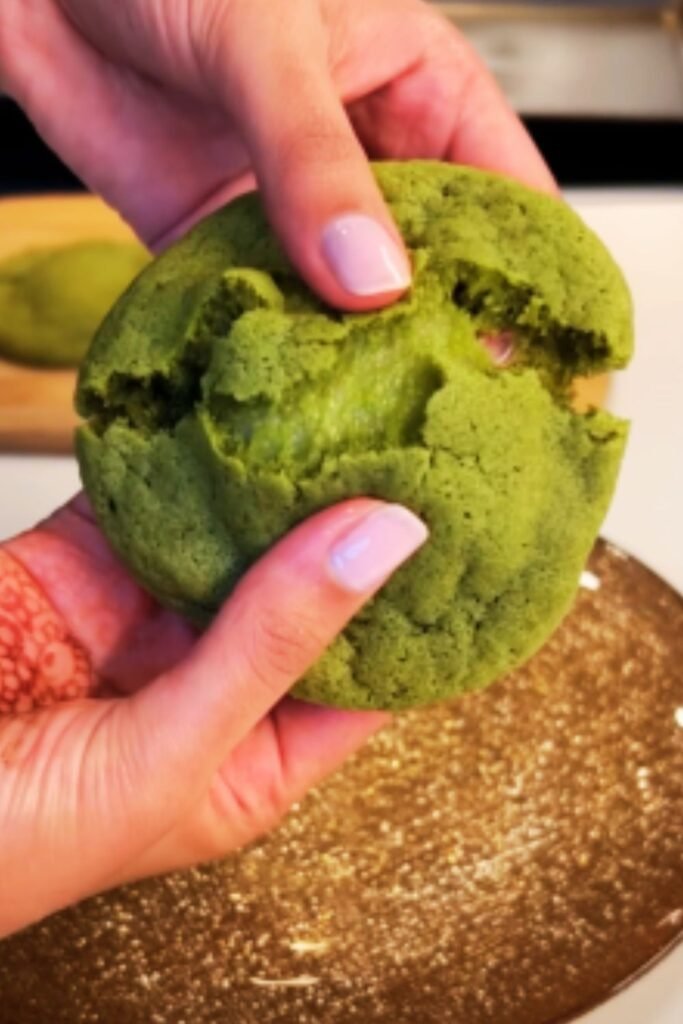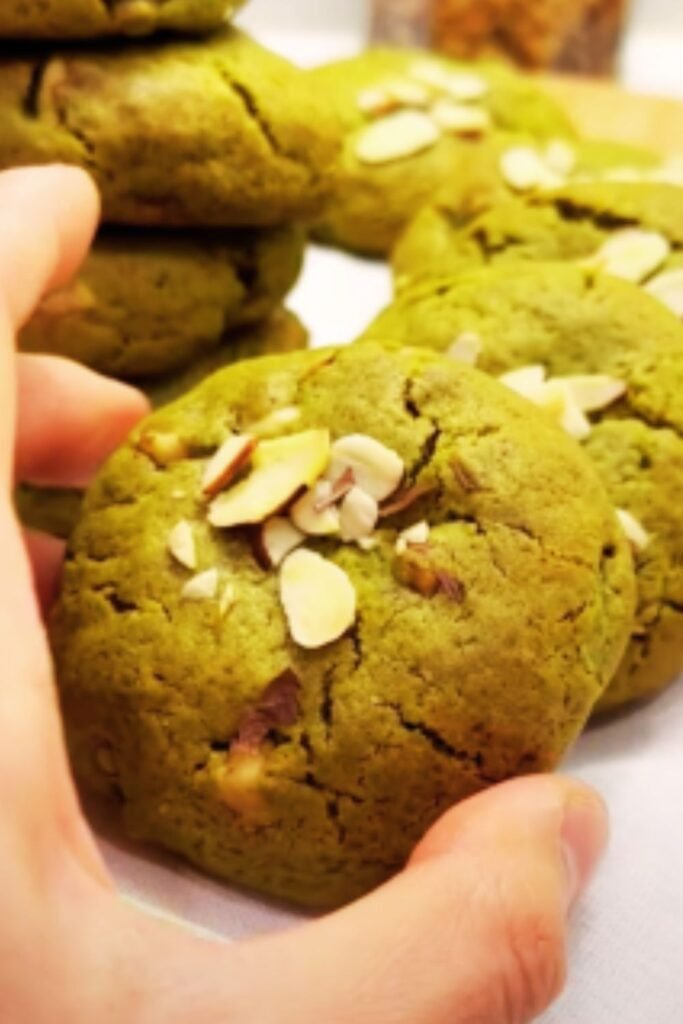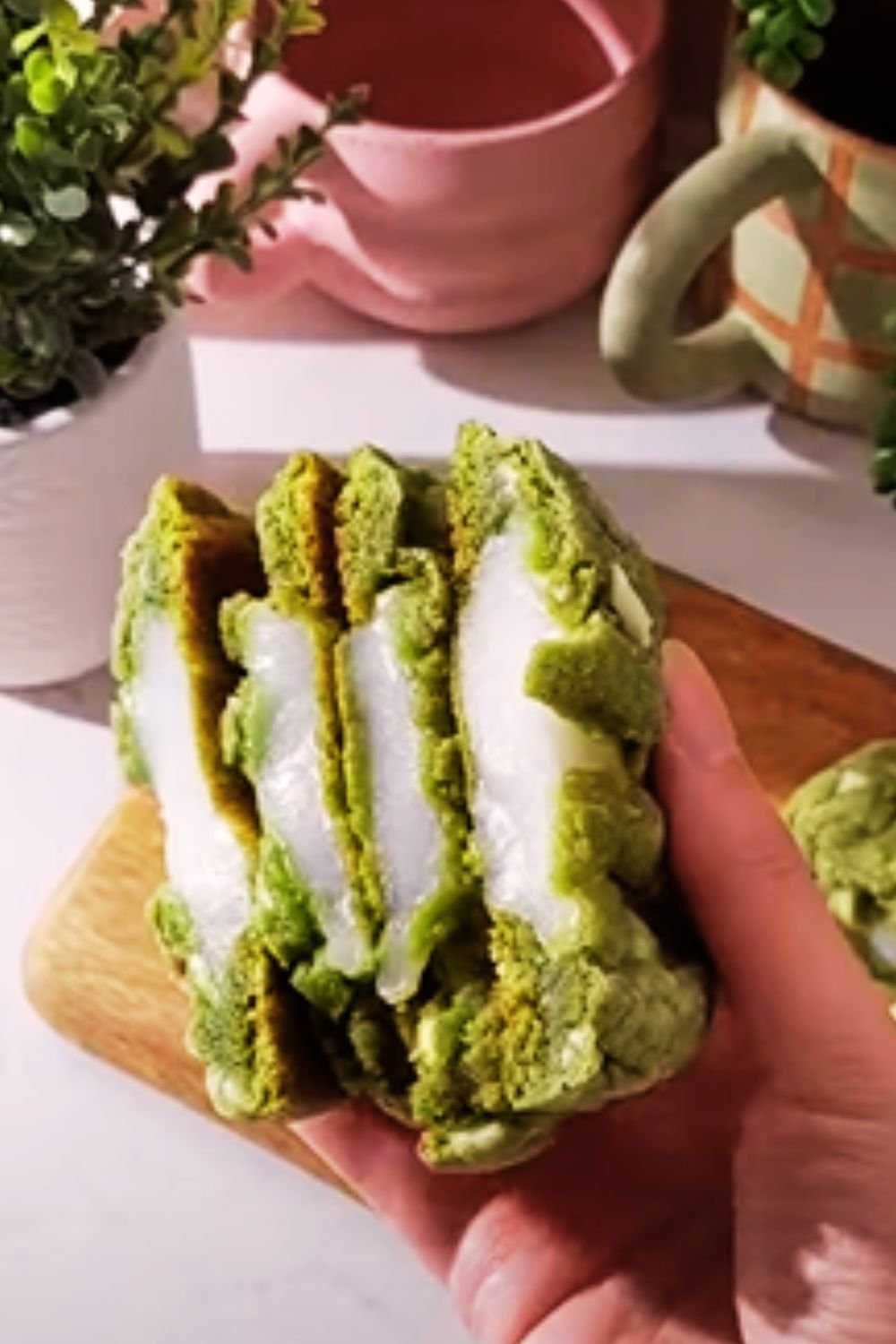There’s something magical about the moment when culinary traditions collide to create something entirely new yet comfortingly familiar. That’s exactly what happened in my kitchen when I first experimented with combining the chewy texture of mochi with the earthy flavor of matcha in cookie form. The result? A treat that’s become my go-to recipe when I want to impress guests or simply treat myself to something special.
These matcha mochi cookies represent the perfect marriage between traditional Japanese ingredients and Western baking techniques. The cookies have a crisp exterior that gives way to a delightfully chewy center, reminiscent of traditional mochi but in a convenient cookie form. The distinctive flavor of matcha green tea powder provides an elegant bitterness that balances the sweetness, creating a sophisticated treat that’s perfect with afternoon tea or as a unique dessert option.
What Makes These Cookies Special
Before diving into the recipe, let me share why these cookies have earned a permanent spot in my baking repertoire:
- Unique Texture: Unlike standard cookies, these have that special mochi chewiness that’s utterly addictive
- Balanced Flavor: The earthiness of matcha counteracts the sweetness for a sophisticated taste
- Visual Appeal: Their vibrant green color makes them stand out on any dessert platter
- Versatility: They pair wonderfully with tea, coffee, or can be enjoyed on their own
- Cultural Fusion: They honor Japanese ingredients while taking the form of a Western favorite
Essential Ingredients Explained
Understanding the key ingredients in these cookies will help you appreciate what makes them so special:
Matcha Powder : High-quality ceremonial or culinary-grade green tea powder that provides the distinctive color and flavor. Matcha contains antioxidants called catechins and offers a gentle caffeine boost.
Glutinous Rice Flour : Also known as sweet rice flour or mochiko, this is what gives the cookies their characteristic chewy texture. Despite its name, it contains no gluten and is made from short-grain sweet rice.
White Chocolate : Adds a creamy sweetness that complements the slightly bitter matcha perfectly. I recommend using high-quality white chocolate with a high cocoa butter content.
Almond Extract : A small amount enhances the flavor profile with subtle nutty notes that pair beautifully with matcha.
The Complete Recipe
Ingredients
For the cookies:
- 1½ cups (170g) all-purpose flour
- ½ cup (60g) glutinous rice flour (mochiko)
- 2 tablespoons (12g) high-quality matcha powder
- ½ teaspoon baking soda
- ¼ teaspoon salt
- ¾ cup (170g) unsalted butter, softened
- ¾ cup (150g) granulated sugar
- ¼ cup (50g) light brown sugar, packed
- 1 large egg, room temperature
- 1 teaspoon vanilla extract
- ¼ teaspoon almond extract
- 1 cup (175g) white chocolate chips
For the optional matcha sugar coating:
- ¼ cup (50g) granulated sugar
- 1 tablespoon matcha powder
Equipment Needed
- Stand mixer or hand mixer
- Mixing bowls
- Measuring cups and spoons
- Cookie scoop (approximately 1.5 tablespoon capacity)
- Baking sheets
- Parchment paper or silicone baking mats
- Cooling rack
- Airtight container for storage

Step-by-Step Instructions
- Prepare your workspace: Preheat your oven to 350°F (175°C). Line two baking sheets with parchment paper or silicone baking mats.
- Mix dry ingredients: In a medium bowl, whisk together the all-purpose flour, glutinous rice flour, matcha powder, baking soda, and salt until well combined and no green streaks of matcha remain.
- Cream butter and sugars: In the bowl of a stand mixer fitted with the paddle attachment (or using a hand mixer), beat the softened butter, granulated sugar, and brown sugar on medium speed for about 3 minutes until light and fluffy. Stop occasionally to scrape down the sides of the bowl.
- Add wet ingredients: Beat in the egg until fully incorporated, then add the vanilla and almond extracts. Mix until smooth, about 1 minute.
- Combine wet and dry ingredients: With the mixer on low speed, gradually add the dry ingredient mixture to the wet ingredients. Mix just until the flour disappears – don’t overmix!
- Add white chocolate: Fold in the white chocolate chips by hand using a spatula.
- Prepare coating (if using): In a small bowl, mix together the granulated sugar and matcha powder for the coating.
- Shape cookies: Using a cookie scoop or tablespoon, portion the dough into 1.5-tablespoon balls. If using the matcha sugar coating, roll each ball in the coating until fully covered. Place cookies on the prepared baking sheets, spacing them about 2 inches apart.
- Bake: Bake in the preheated oven for 10-12 minutes. The cookies should be set around the edges but still slightly soft in the center. They won’t brown much due to the matcha, so be careful not to overbake.
- Cool: Allow the cookies to cool on the baking sheets for 5 minutes before transferring to a wire rack to cool completely.

Matcha Selection Guide
The quality of matcha you choose will significantly impact your cookies’ flavor. Here’s a comprehensive guide to help you select the right matcha for your baking needs:
| Grade | Characteristics | Best For | Price Range | Notes |
|---|---|---|---|---|
| Ceremonial Grade | Vibrant green color, smooth texture, sweet and delicate flavor | Drinking as tea, special occasion baking | $25-40 per 30g | The highest quality; produces cookies with a more authentic and nuanced matcha flavor |
| Premium Culinary Grade | Bright green color, slightly less sweet than ceremonial | Everyday baking, lattes | $15-25 per 30g | Excellent balance of quality and value for these cookies |
| Standard Culinary Grade | Less vibrant green, stronger bitter notes | Baking, ice cream | $8-15 per 30g | Acceptable for cookies but may have a more astringent taste |
| Ingredient Grade | Dull green/yellowish, notably bitter | Mass production, color additive | $5-8 per 30g | Not recommended for these cookies as the flavor will be compromised |
I recommend using at least a premium culinary grade matcha for these cookies. While ceremonial grade will produce the most authentic flavor, a good culinary grade matcha will still yield excellent results at a more accessible price point.
The Science Behind Mochi Cookies
What exactly happens when you incorporate glutinous rice flour into a cookie recipe? Let me explain the fascinating food science at play:
When glutinous rice flour (mochiko) is heated in the presence of moisture, its starch granules absorb water and swell. This process, called gelatinization, creates that distinctive chewy texture we associate with mochi. In these cookies, we’re creating a hybrid texture where some parts of the cookie bake like a traditional cookie (crisp edges), while the mochiko contributes pockets of chewiness.
The proportion of glutinous rice flour to all-purpose flour is crucial. Too much mochiko, and the cookies won’t spread properly; too little, and you’ll miss that characteristic chewiness. The 1:3 ratio in this recipe has been tested extensively to achieve the perfect balance.
Troubleshooting Common Issues
Even experienced bakers can encounter challenges. Here are solutions to common problems when making matcha mochi cookies:
Cookies Spreading Too Much
- Chill the dough for 30 minutes before baking
- Check that your butter wasn’t too warm
- Make sure your baking soda is fresh
- Add 2 additional tablespoons of all-purpose flour to the next batch
Cookies Not Spreading Enough
- Slightly flatten the dough balls before baking
- Ensure your oven is properly preheated
- Use room temperature (not cold) butter
- Check that you measured the flour correctly (spoon and level, don’t scoop)
Matcha Flavor Too Weak
- Use higher quality matcha
- Add an additional ½-1 teaspoon of matcha powder
- Store matcha properly in an airtight container in the refrigerator
- Check the freshness date on your matcha
Cookies Too Dry
- Reduce baking time by 1-2 minutes
- Add 1 tablespoon of milk to the dough
- Make sure you’re not overmeasuring the flour
Storage and Serving Suggestions
These matcha mochi cookies maintain their optimal texture and flavor under proper storage conditions:
Storage Options
- Room Temperature: Store in an airtight container for up to 3 days. Place a slice of bread in the container to maintain moisture.
- Refrigerator: For longer freshness, store in the refrigerator for up to 1 week. Allow cookies to come to room temperature before serving for the best texture.
- Freezer: Freeze baked cookies in a single layer, then transfer to a freezer-safe container with parchment between layers. They’ll keep for up to 3 months. Thaw at room temperature.
- Dough Freezing: Roll the cookie dough into balls, freeze on a baking sheet until solid, then transfer to a freezer bag. Bake from frozen, adding 1-2 minutes to the baking time.

Serving Suggestions
These cookies pair wonderfully with a variety of beverages and accompaniments:
- Serve with traditional Japanese green tea for an authentic pairing
- Match with a frothy matcha latte for double the matcha enjoyment
- Contrast with a cup of black coffee to balance the sweetness
- Offer alongside fresh berries for a refreshing contrast
- Create ice cream sandwiches using vanilla ice cream between two cookies
- Drizzle with additional melted white chocolate before serving for extra decadence
- Sprinkle with black sesame seeds for visual contrast and subtle flavor enhancement
- Serve with a small dish of sweet red bean paste (anko) on the side for traditional flair
Creative Variations to Try
Once you’ve mastered the basic recipe, consider these delicious variations:
Black Sesame Swirl
Divide the dough in half. Add 2 tablespoons of black sesame paste to one half. Roll each half into ropes, twist together, and cut into cookies.
Matcha White Chocolate Sandwich Cookies
Make smaller cookies, then sandwich them with a white chocolate ganache filling (4 oz melted white chocolate mixed with 2 tablespoons heavy cream).
Hojicha Version
Replace the matcha with an equal amount of hojicha (roasted green tea) powder for a nuttier, toasted flavor profile.
Yuzu Matcha
Add 1 teaspoon of yuzu zest (or regular lemon zest with a drop of orange extract) for a bright citrus note that complements the earthy matcha.
Coconut Matcha Mochi
Add ½ cup of shredded coconut to the dough and replace half the butter with coconut oil for a tropical twist.
Nutrition Information
For those who are health-conscious or have dietary considerations, here’s the approximate nutritional information for one cookie (based on a yield of 24 cookies):
| Nutrient | Amount per Cookie |
|---|---|
| Calories | 165 |
| Total Fat | 8g |
| Saturated Fat | 5g |
| Cholesterol | 22mg |
| Sodium | 65mg |
| Total Carbohydrates | 22g |
| Dietary Fiber | 0.5g |
| Sugars | 13g |
| Protein | 2g |
| Caffeine | ~8mg |
Additionally, these cookies contain small amounts of antioxidants from the matcha powder, which is known for its health benefits. However, they should still be enjoyed in moderation as part of a balanced diet.
Frequently Asked Questions
Q: Can I make these cookies gluten-free? Yes! The glutinous rice flour is already gluten-free (despite its name). Simply replace the all-purpose flour with a 1:1 gluten-free flour blend. I’ve tested this with both Bob’s Red Mill and King Arthur gluten-free flour blends with excellent results.
Q: Why are my cookies not as green as I expected? The intensity of the green color depends greatly on the quality and freshness of your matcha powder. Lower quality or older matcha tends to have a more dull, yellowish-green color. For vibrant green cookies, use fresh, high-quality matcha and store it properly in an airtight container in the refrigerator.
Q: Can I reduce the sugar in this recipe? You can reduce the total sugar by up to 25% without significantly affecting the texture. However, keep in mind that the sugar helps balance the natural bitterness of the matcha. If reducing the sugar, you might also want to reduce the matcha slightly to maintain flavor balance.
Q: Is there a dairy-free option for these cookies? Absolutely! Replace the butter with equal amounts of softened coconut oil or a plant-based butter substitute. For the white chocolate chips, look for dairy-free white chocolate alternatives or substitute with regular dairy-free chocolate chips if the white chocolate flavor isn’t essential to you.
Q: Why add glutinous rice flour instead of making regular matcha cookies? The glutinous rice flour is what gives these cookies their unique chewy texture similar to mochi. Without it, you’d have delicious matcha cookies, but you’d miss out on that special textural element that makes these cookies stand out.
Q: How can I tell when the cookies are done since they don’t brown much? Look for slight firmness around the edges while the center remains soft. The bottoms should be just barely turning golden. If you gently press the edge, it should feel set. Remember that they’ll continue to firm up as they cool.
Q: Can I make the dough ahead of time? Yes! The dough can be refrigerated for up to 3 days. Allow it to sit at room temperature for about 15 minutes before scooping and baking, or the cookies may not spread properly.
Q: What if I can’t find glutinous rice flour? Look for it in Asian grocery stores where it may be labeled as “sweet rice flour” or “mochiko.” If you absolutely cannot find it, you can use all-purpose flour, but you’ll lose the chewy mochi texture that makes these cookies special.
Cultural Context and History
As someone who loves exploring the cultural significance of ingredients, I find it fascinating how these cookies represent modern culinary fusion. Matcha has been central to Japanese tea ceremonies for centuries, valued for both its flavor and meditative preparation process. Traditional mochi, made from pounded glutinous rice, dates back to ancient Japan and was originally associated with religious offerings and celebrations.
By combining these traditional Japanese ingredients with the Western cookie format, we create something that honors both culinary traditions while establishing something new. This type of culinary fusion represents how food continues to evolve as cultures connect and inspire each other.
When sharing these cookies with friends and family, I love to explain the cultural significance of the ingredients. It adds an extra dimension of appreciation to the eating experience and sparks interesting conversations about food history and tradition.
A Final Note
Baking these matcha mochi c


